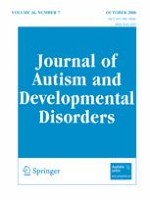01-10-2006 | ORIGINAL PAPER
Patterns of Reading Ability in Children with Autism Spectrum Disorder
Gepubliceerd in: Journal of Autism and Developmental Disorders | Uitgave 7/2006
Log in om toegang te krijgenAbstract
This study investigated reading skills in 41 children with autism spectrum disorder. Four components of reading skill were assessed: word recognition, nonword decoding, text reading accuracy and text comprehension. Overall, levels of word and nonword reading and text reading accuracy fell within average range although reading comprehension was impaired. However, there was considerable variability across the sample with performance on most tests ranging from floor to ceiling levels. Some children read accurately but showed very poor comprehension, consistent with a hyperlexia reading profile; some children were poor at reading words and nonwords whereas others were unable to decode nonwords, despite a reasonable level of word reading skill. These findings demonstrate the heterogeneous nature of reading skills in children with ASD.
